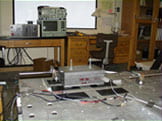Geosynthetic Interfaces
Abstract:
The dynamic response of geosynthetic interfaces commonly used in Municipal Solid Waste Landfills were investigated using a shaking table facility. Geosynthetic interfaces placed horizontally and on inclined surfaces were tested to simulate bottom and cover liner systems. Results show that the shear stress, and therefore acceleration, that can be transmitted through a geosynthetic interface is limited. Beyond this acceleration, relative displacement (slip) occurs along the interface. The force-slip relationships for various interfaces were also investigated. Typical relationships show almost rigid and then plastic deformation where the maximum shear force transmitted increases slightly with increasing slip. A stick-slip behavior along the interfaces were also observed, which momentarily increased the shear force transmitted through the interface. The dynamic shear behavior of the interfaces were also tested under earthquake excitations. The response spectra of the motions transmitted through the interfaces, and the corresponding spectra of the shaking table motions were compared to understand the dynamic interface shear behavior of the interfaces under earthquake excitations. Based on the measured slips along the interfaces, normalized plots were prepared that can be used to estimate the maximum (peak-to-peak) slip along horizontally placed geosynthetic interfaces. In addition, plots of normalized permanent slip per cycle of harmonic excitation along geosynthetic interfaces placed on various slope inclinations were developed. Example calculations to demonstrate the use of these plots are included in this report.
Realistic analysis of dynamic response of a landfill that has geosynthetic liners requires the proper modeling of the liner responses within the landfill. In this research such a model was developed and integrated in a one- dimensional wave propagation analysis procedure, thus allowing the calculation of slip along geosynthetic liners placed in landfills. This report presents constitutive models that were developed to describe the dynamic response of a geomembrane/geotextile interface. The models were validated by comparing the calculated slips and accelerations with the values measured from the shaking table tests. One of the models describes a geosynthetic liner response through an equivalent soil layer. This equivalent soil layer was incorporated in the SHAKE program for dynamic analysis of one-dimensional landfill profiles. Example analyses of typical landfill cross sections were analyzed using earthquake records of different frequency bands. Transmitted accelerations, landfill bottom liner shears and slips along the bottom and cover liners were calculated for landfills of different heights. The results clearly demonstrate the de-amplifying effects of the bottom and cover liners on the responses of the landfill waste, the drainage layers and cover liners. This effect is most pronounced when the earthquake ground motion is in resonance with the landfill cross section.
Relevant Publications:
- Georgarakos. P. Yegian. M. K., and Gazetas, G. (2005). “In-Ground Isolation Using Geosynthetic Liners”, 9th World Seminar on Seismic Isolation, Energy Dissipation and Active Vibration Control of Structures, Kobe, Japan, June.
- Yegian, M.K., Kadakal, U. and Catan, M. (1999). “Geosynthetic for Earthquake Hazard Mitigation”. Geosynthetics ’99 Boston, Mass. April.
- Yegian, M.K. and Kadakal, U. (1998). “Dynamic Response Analysis Procedure for Landfills with Geosynthetic Liners” ASCE Journal of Geotechnical and Geoenvironmental Engineering, October.
- Yegian, M.K. and Kadakal, U. (1998). “Modeling Geosynthetic Liners in Dynamic Response Analysis of Landfills”. ASCE Geotechnical Earthquake Engineering Conference, GSP No. 75, Seattle, Washington, August.
- Yegian, M.K. and Kadakal, U. (1998). “Seismic Response of Landfills with Geosynthetic Liners”. Sixth International Conference on Geosynthetics, Atlanta, Georgia, March 25-29.
- Yegian, M.K. and Kadakal, U. (1998). “Geosynthetic Interface Behavior Under Dynamic Loads” The Geosynthetic International Journal, Volume 5.
- Yegian, M.K. and Harb, J. (1995) “Slip Displacements of Geosynthetic Systems Under Dynamic Excitations,” Earthquake Design and Performance of Solid Waste Landfills, ASCE Geotechnical Special Publication No. 54, October.
- Yegian, M.K., Yee, A.Y. and Harb, J.N. (1995) “Seismic Response of Geosynthetic/Soil Systems,” Geoenvironment 2000, ASCE Specialty Conference, New Orleans, LA, February.
- Yegian, M.K., Yee, Z.Y., and Harb J.N. (1995). “Response of Geosynthetics Under Earthquake Excitations,” Geosynthetics ‘95 Conference, Nashville, TN, February.
- Lahlaf, A. and M.K. Yegian. (1993). “Shaking Table Tests for Geosynthetic Interfaces.” Proceedings of the Geosynthetics 93’ Conference, Vancouver, Canada, March.
- Yegian, M.K. and Lahlaf, A. (1992). “Geomembranes As Base-Isolation,” Geosynthetic Fabric Report, September.
- Yegian, M.K. and Lahlaf, A. (1992). “Dynamic Interface Shear Properties of Geomembranes and Geotextiles.” Journal of the Geotechnical Engineering Division ASCE, May.
- Yegian, M.K. and Lahlaf.A. (1992). “Kettleman Hills Waste Landfill Slope Failure. I: Linear-System Properties” (discussion), Journal of Geotechnical Engineering Division, ASCE, April.
